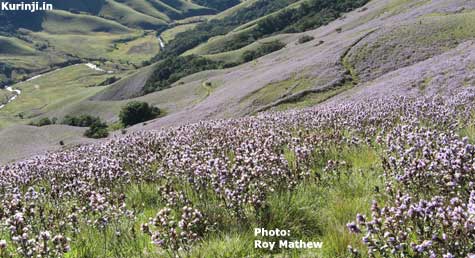 Neelakurinji
(Strobilanthes kunthiana) is a shrub that used to grow
abundantly in the shola
grasslands of Western Ghats in India. The
Nilgiris, which literally means the blue mountains, got
its name from the purplish blue flowers of Neelakurinji
that blossoms gregariously once in 12 years. Neelakurinji
(Strobilanthes kunthiana) is a shrub that used to grow
abundantly in the shola
grasslands of Western Ghats in India. The
Nilgiris, which literally means the blue mountains, got
its name from the purplish blue flowers of Neelakurinji
that blossoms gregariously once in 12 years.Once they used to cover the entire Nilgiris like a carpet during its flowering season. However, now plantations and dwellings occupy much of their habitat. Neelakurinji is the best known of a genus whose members have flowering cycles ranging from one to 16 years. It belongs to the family of Acanthaceae. The genus has more than 500 species, of which at least 56 occur in India. Besides the Western Ghats, Neelakurinji is seen in the Shevroys in the Eastern Ghats. It occurs at altitudes of 1300 to 2400 metres.  The
plant is usually 30 to 60 cms high on the hills. They
can, however, grow well beyond 180 cm under congenial
conditions at lower elevations. Plants that bloom at
long intervals like kurinji are called plietesials. The
plant is usually 30 to 60 cms high on the hills. They
can, however, grow well beyond 180 cm under congenial
conditions at lower elevations. Plants that bloom at
long intervals like kurinji are called plietesials. |